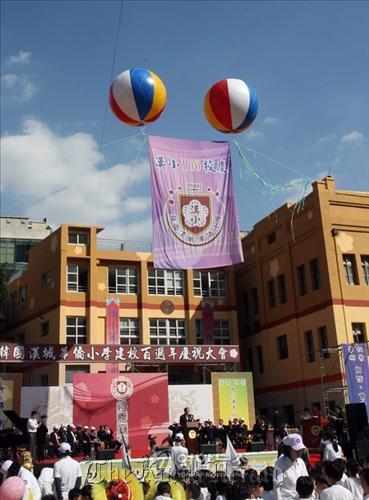As classes are about to end at Hanseong Chinese Primary School in downtown Seoul, parents line up outside to pick up their children. Most are Chinese parents but some are Korean mothers.
English is by far the language that most Korean parents want their children to learn. But their focus is shifting, albeit slowly, to the Chinese language as China has emerged as the world’s second largest economy.
“I’m sending my child to the Chinese school because the Chinese language is necessary in this global era,” said one Korean parent who did not want to be named. “I expect that China will open its door wider and it would give my child more job opportunities.”

Hanseong Chinese Primary School in Seoul (Yonhap News)
South Korean parents are known for their zeal for educating their children. Many would do almost anything if it can better their children’s chances of getting into prestigious schools. They spend a small fortune on private education and after-school tutoring.
So far, most of their focus has been on learning English.
Competitive, ambitious parents send their children abroad from a very early age so that they can speak English like a native. Higher English language test scores, including TOEIC and TOEFL, are regarded as tickets to highly-paid jobs.
According to government data, more than 12,000 elementary school children studied abroad in 2008, and around 80 percent of them chose English-speaking countries such as the United States, Canada and Australia.
However, in recent years, Chinese has emerged as the second most favored language in terms of landing jobs in South Korea. A growing number of people are taking Chinese language proficiency tests and going to China or Taiwan to improve their Chinese skills.
For example, Samsung Group, South Korea’s biggest conglomerate and a favorite of jobseekers, decided that from this year on, it will give additional points toward employment and promotion to those who have done well on Chinese proficiency tests.
Moving quicker than the business community, South Korean parents are already looking to ethnic Chinese kindergartens and elementary schools in the country for their children. It’s an easier and cheaper option than sending their children to China.
“I’m very satisfied with having my kid study here,” said the mother who was waiting outside Hanseong, the oldest and largest Chinese school in South Korea. “It’s important that my kid can speak Chinese. He can learn other subjects in Chinese. The advantage is huge. You can’t compare it with other Korean schools.”
Kim Ji-eun, a 12-year-old Korean girl, said she is very happy to go to a Chinese school in Seoul.
“When I first learned Chinese, I wanted to study more,” said Kim, a sixth grader at Hanseong. “I told my parents that I wanted to go to a Chinese school and they allowed me to attend here.”
According to the South Korean education ministry, there are 11 Chinese elementary schools in the country, of which two are in Seoul. Some 150 of the 1,200 students enrolled at those two schools are Korean.
“Well, I’m going to send my first kid to a Chinese preschool next year,” said Park Yeo-jin, who runs an online club focusing on ethnic Chinese schools on Naver, the largest portal in South Korea.
She has a 4-year-old child and is pregnant with her second baby.
“I want my second kid (to go to a Chinese school), too,” she said.
Her club has some 530 members, mostly mothers who have preschool-aged kids and want to share information on Chinese schools and learning Chinese. There are two to three similar online cafes with thousands of members between them.
“Many parents want their children to study at Chinese schools because they know Chinese is getting popular in the job market, and they can get admission to Chinese schools relatively easily compared to other foreign schools here, and it’s cheaper, obviously,” she said.
By law, foreign schools in South Korea are allowed to accept South Korean nationals for up to 30 percent of their enrollment quota.
“(South Korea’s) foreign school regulations were revised in 2009 and now allow South Korean nationals to enter Chinese schools if they have lived in a foreign country for at least three years, down from five,” said an official at Hanseong. “Since then, the number of Koreans has started to rise.”
One mother said she had her son transfer to the Chinese elementary school right after the law was revised.
“My family lived in Singapore for years and learned Chinese there,” she said, wanting to be identified only by her family name, Jeong. “For years, Koreans were not accepted. But the law changed and I decided to send my son to an ethnic Chinese school.”
According to Hanseong, some 10 percent of its students are Koreans. The school provides a Chinese-only curriculum and there are no special language classes or courses for Korean students who are not good at Chinese.
“We require them (students) to have a certain level of Chinese skills. Without knowing Chinese, they can’t keep pace with their friends in class. But still there are many who want to come,” said the Hanseong official.
Cheap tuition is an extra benefit.
Tuition can go up to 4 million won ($3,700) a year for a child at Hanseong, but that’s cheap compared to the about 20 million won needed to study in China. Schools like Hanseong are even more of a bargain when including the extra money needed for rent and other living expenses in China.
One clear disadvantage is that ethnic Chinese schools are not recognized as official school education in South Korea. Graduates of these schools have to take state certificate examinations to show they have acquired the same level of academic achievement as students in Korean schools.
(Yonhap News)





![[KH Explains] How should Korea adjust its trade defenses against Chinese EVs?](http://res.heraldm.com/phpwas/restmb_idxmake.php?idx=645&simg=/content/image/2024/04/15/20240415050562_0.jpg&u=20240415144419)
